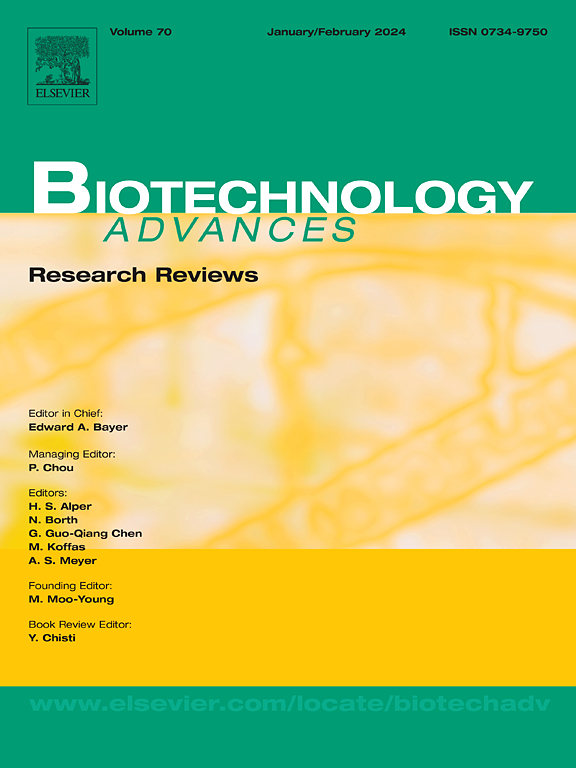弯曲血蜱的系统生物学——寄生虫控制的生物技术进展。
IF 12.1
1区 工程技术
Q1 BIOTECHNOLOGY & APPLIED MICROBIOLOGY
引用次数: 0
摘要
寄生线虫是一种严重的全球负担,影响着动物健康、农业和世界各地的经济。在这些蠕虫中,反刍动物的一种吸血线虫——弯血线虫是一种主要的病原体,也是分子和应用寄生虫学研究的一个模型。本文综述了弯曲线虫在分子生物学、遗传多样性和宿主-寄生虫相互作用方面的一些重要进展,并强调了弯曲线虫与秀丽隐杆线虫的比较研究价值。关键主题包括基因组学、转录组学和蛋白质组学技术和资源的最新发展,这些技术和资源阐明了关键的分子途径,包括泛素化途径、蛋白酶/蛋白酶抑制剂系统和弯毛鼠的分泌组。其中一些见解为确定基本基因和探索其作为新型驱虫药或疫苗靶点的潜力提供了基础,特别是在面对广泛的驱虫药耐药性的情况下。先进的生物信息学工具,如机器学习(ML)算法和人工智能(AI)驱动的蛋白质结构预测,正在增强注释能力,促进和加速对基因功能、生物途径和过程的分析。这篇综述还讨论了这些工具与尖端的单细胞测序和空间转录组学的整合,以在细胞水平上解剖宿主-寄生虫的相互作用。讨论强调了有组织的数据库、改进的培养系统和功能基因组学平台对于将分子发现转化为实际成果(例如新的干预措施)的重要性。新的研究成果和资源不仅推动了对弯纹线虫及其相关线虫的研究,而且可能为创新解决抗虫性全球挑战铺平道路。本文章由计算机程序翻译,如有差异,请以英文原文为准。
Systems biology of Haemonchus contortus – Advancing biotechnology for parasitic nematode control
Parasitic nematodes represent a substantial global burden, impacting animal health, agriculture and economies worldwide. Of these worms, Haemonchus contortus – a blood-feeding nematode of ruminants – is a major pathogen and a model for molecular and applied parasitology research. This review synthesises some key advances in understanding the molecular biology, genetic diversity and host-parasite interactions of H. contortus, highlighting its value for comparative studies with the free-living nematode Caenorhabditis elegans. Key themes include recent developments in genomic, transcriptomic and proteomic technologies and resources, which are illuminating critical molecular pathways, including the ubiquitination pathway, protease/protease inhibitor systems and the secretome of H. contortus. Some of these insights are providing a foundation for identifying essential genes and exploring their potential as targets for novel anthelmintics or vaccines, particularly in the face of widespread anthelmintic resistance. Advanced bioinformatic tools, such as machine learning (ML) algorithms and artificial intelligence (AI)-driven protein structure prediction, are enhancing annotation capabilities, facilitating and accelerating analyses of gene functions, and biological pathways and processes. This review also discusses the integration of these tools with cutting-edge single-cell sequencing and spatial transcriptomics to dissect host-parasite interactions at the cellular level. The discussion emphasises the importance of curated databases, improved culture systems and functional genomics platforms to translate molecular discoveries into practical outcomes, such as novel interventions. New research findings and resources not only advance research on H. contortus and related nematodes but may also pave the way for innovative solutions to the global challenges with anthelmintic resistance.
求助全文
通过发布文献求助,成功后即可免费获取论文全文。
去求助
来源期刊

Biotechnology advances
工程技术-生物工程与应用微生物
CiteScore
25.50
自引率
2.50%
发文量
167
审稿时长
37 days
期刊介绍:
Biotechnology Advances is a comprehensive review journal that covers all aspects of the multidisciplinary field of biotechnology. The journal focuses on biotechnology principles and their applications in various industries, agriculture, medicine, environmental concerns, and regulatory issues. It publishes authoritative articles that highlight current developments and future trends in the field of biotechnology. The journal invites submissions of manuscripts that are relevant and appropriate. It targets a wide audience, including scientists, engineers, students, instructors, researchers, practitioners, managers, governments, and other stakeholders in the field. Additionally, special issues are published based on selected presentations from recent relevant conferences in collaboration with the organizations hosting those conferences.
 求助内容:
求助内容: 应助结果提醒方式:
应助结果提醒方式:


